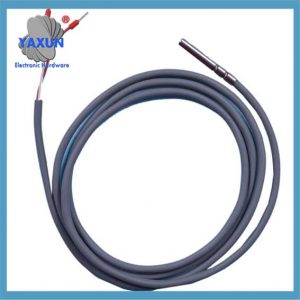Kaj so termistorji NTC in PTC? Za tiste, ki še nikoli niso bili izpostavljeni NTC, PTC ali so bili pravkar izpostavljeni NTC in PTC, Ne vedo, kaj sta NTC in PTC. seveda, Relativno preprosto je razumeti koncepte NTC in PTC, Ko pa iščete informacije in vidite veliko zmedenih strokovnih izrazov, pa tudi nekaj strojne opreme, Morda ste malo omamljeni, Navsezadnje, Nikoli jim niste bili izpostavljeni in vaš um je poln vprašanj. Za začetnike ali programske inženirje, ki želijo začeti projekt, Najbolje je, da čim prej imamo predhodno razumevanje, Naučite se osnovnih načel, in zaženite pravilne podatke s kodo. Navsezadnje, učenje je postopno, In ne moreš se poglobiti v njena načela naenkrat.
1. Kaj so termistorji NTC in PTC?
NTC in PTC sta oba termistorja, ki so posebni upori, ki lahko spreminjajo upor s temperaturo. Lahko rečemo tudi, da so neke vrste senzorji.
NTC in PTC sta obe vrsti termistorjev, ki so temperaturno občutljivi upori, kjer se zavzema NTC “Negativni temperaturni koeficient” kar pomeni, da se njegova odpornost zmanjšuje, ko se temperatura povečuje, medtem ko PTC stoji “Pozitiven temperaturni koeficient” kar pomeni, da se njegova odpornost povečuje z dvigom temperature; v bistvu, NTC termistorji se običajno uporabljajo za zaznavanje temperature, Medtem ko se PTC Termistorji pogosto uporabljajo za zaščito vezja zaradi svojih samoodresilnih zmogljivosti.
Razlika je v tem, da je NTC negativni temperaturni koeficient, in PTC je termistor s pozitivnim temperaturnim koeficientom.
Termistor s pozitivnim temperaturnim koeficientom (PTC): Vrednost odpornosti se poveča s povečanjem temperature;
Termistor negativnega temperaturnega koeficienta (NTC): Vrednost odpornosti se z naraščanjem temperature zmanjšuje;
Ii. Aplikacije NTC in PTC
1. Aplikacije NTC:
Uporablja se za zaznavanje temperature, Na splošno tipa meritve temperature NTC
Uporablja se za zatiranje prenapetosti, Na splošno tip moči ntcntc termistor:
Odpornost se z naraščanjem temperature zmanjšuje.
Široko se uporablja za merjenje temperature.
Se lahko uporablja kot omejitve tokov vdori v vezjih.
2. Aplikacije PTC vključujejo:
V zaščitnih vezjih, na primer zaščito predtemperature, zaščita pred tokom
V zagonskih vezjih
Odpornost se povečuje s povečanjem temperature.
Pogosto se uporabljajo kot samoresitajoče varovalke za zaščito vezij pred pretiranimi situacijami.
Lahko v določenih aplikacijah deluje kot samoregulirajoči ogrevalni element.
Iii. B Vrednost
B Vrednost: konstantna materiala, Parameter, ki se uporablja za označevanje amplitude uporne vrednosti NTC s spremembo temperature v območju delovne temperature, ki je povezan s sestavo materiala in postopkom sintranja. B vrednost je običajno numerična (3435K, 3950K).
Večja je vrednost B, Hitreje se vrednost odpornosti zmanjšuje s povečanjem temperature, in manjša vrednost B, Nasprotno je res.
V vrednosti B se v tem članku ne uporablja, Ampak samo za razumevanje. Temperaturo lahko izračunamo tudi po metodi izračuna vrednosti temperaturnega koeficienta, ki ga lahko imenujemo tudi algoritem temperature Kelvin.
4. R25
R25: Vrednost odpornosti telesa NTC pri 25 ℃.
5. Načela analiza
Kot primer vzemite NTC, Splošni shematični diagram je naslednji:
Načela analiza:
Funkcija ADC se uporablja za zbiranje napetosti.
R1 in R2 sta serijska vezja. Glede na formulo serijskih uporov napetosti, imamo:
R = R1+R2;
Od i = u/r = u/(R1+R2), nato:
U1 = ir1 = u(R1/(R1+R2))
U2 = ir2 = u(R2/(R1+R2))
Uporabljamo u2 = ir2 = u(R2/(R1+R2)) In to je to.
Podatki, ki jih zbira ADC, se pretvorijo v napetost, ki je napetost U2, tako
U(R2/(R1+R2))= ADC/1024*U.
Tukaj 1024 je 10-bitna ločljivost ADC mikrokontrolerja, ki ga uporabljam, to je, 1024
Tu vemo, da u = 3.3V, ki je vcc na sliki, Vrednost R1 je 10K, in r2 je ntc, Torej njegova vrednost zaenkrat ni znana. U je lahko izravnana.
Končna formula je: R2 = ADC*R1/1024-ADC
To je, R2 = ADC*10000/1024-ADC
Po pridobitvi odpornosti vrednosti R2, Temperaturo lahko dobimo tako, da jo primerjamo s tabelo upora. Tabelo za primerjavo odpornosti na splošno ponuja trgovec po nakupu.
Naprej, Pojdimo na kodo. Tukaj, Za pretvorbo temperature uporabljamo metodo iskanja tabele NTC. To kodo lahko uporabite tako, da samo dodate svojo vrednost ADC.
const nepodpisan int temp_tab[]={
119520,113300,107450,101930,96730,91830,87210,82850,78730,74850,//-30 do -21,
71180,67710,64430,61330,58400,55620,53000,50510,48160,45930,//-20 do -11,
43810,41810,39910,38110,36400,34770,33230,31770,30380, 29050,//-10 do -1,
27800,26600,25460,24380,23350,22370,21440,20550,19700,18900,18130,//0-10,
17390,16690,16020,15390,14780,14200,13640,13110,12610,12120,//11-20,
11660,11220,10790,10390,10000,9630,9270,8930,8610,8300, //21-30, 8000,7710,7430,7170,6920,6670,6440,6220,6000,5800,//31-40, 5600,5410,5230,5050,4880,4720,4570,4420,4270,4130,//49-50, 4000,3870,3750,3630,3510,3400,3300,3190,3090,3000,//51-60, 2910,2820,2730,2650,2570,24 90,2420,2350,2280,2210,//61-70, 2150,2090,2030,1970,1910,1860,1800,1750,1700,1660,//71-80, 1610,1570,1520,1480,1440,1400,1370,1330,1290,1260,//81-90 1230,1190,1160,1130,1100,1070,1050,1020,990,//91-99, };
Kratek ADC; // Pridobite vrednost ADC v NTC
Kratek NTC_R; // Vrednost odpornosti NTC
#Določite R1 10000
void get_temp()
{
kratka temp;
Kratek CNT;
Adc = adc_get_value(Adc_ch_0); // Pridobite vrednost ADC
printf(“———–ADC:%d n n”,ADC);
Ntc_r = adc*r1/(1024-ADC);
cnt = 0;
temp = -30;
naredi{
če(temp_tab[cnt] < Ntc_r){ // Vrednost tabele je manjša od izračunane vrednosti upora, izstop, da dobite temperaturo
odmor;
}
++temp;
}medtem ko(++cnt < sizeof(temp_tab)/4); // Velikost tabele zanke, to je, Številokrat
printf(“Ntc_r:%d temp:%d n n”,Ntc_r,temp);
}
 English
English العربية
العربية Български
Български 粤语
粤语 中文(简体)
中文(简体) 中文(漢字)
中文(漢字) Nederlands
Nederlands Suomi
Suomi Français
Français Deutsch
Deutsch Ελληνικά
Ελληνικά Magyar
Magyar Italiano
Italiano 日本語
日本語 한국어
한국어 Polski
Polski Português
Português Română
Română Русский
Русский Slovenščina
Slovenščina Español
Español Svenska
Svenska ภาษาไทย
ภาษาไทย Türkçe
Türkçe Tiếng Việt
Tiếng Việt




